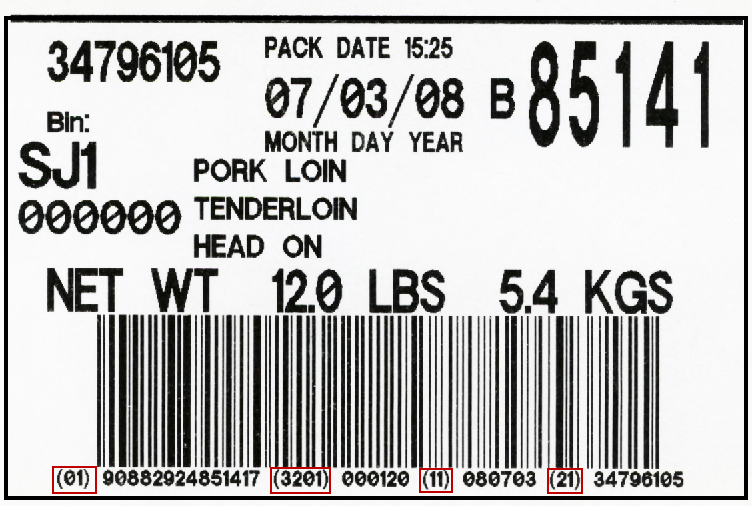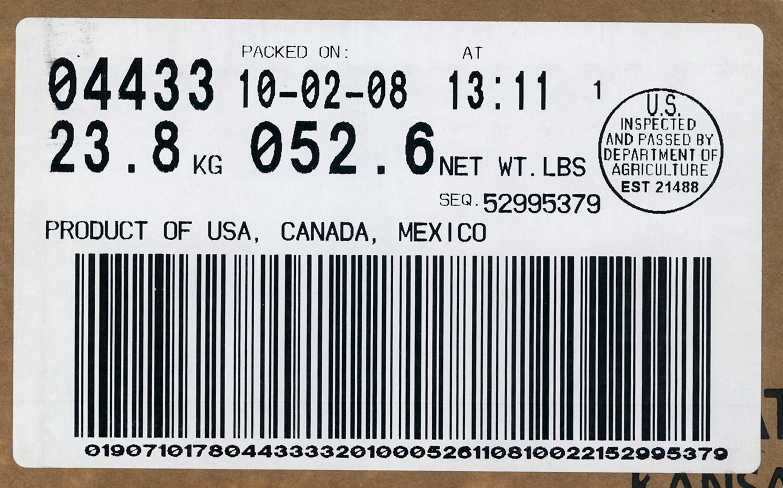GS1 Bar Code Standard
This chapter will provide you with an explanation of how bar code symbologies are structured by using the GS1 Bar Code standard as the example. Normal bar code labels and many other bar code symbologies can also be defined and processed in EWM. A glossary of terms has also been included at the end of this guide to clarify the terminology used in relation to a GS1 bar code definition. Some of the terminology in the glossary is common to the topic of bar code definitions.
The GS1 Bar Code standard uses a special variation of the "Code 128" bar code symbology which most scanners currently recognize as "UCC-128" or "EAN-128".
Application Identifiers
The GS1 standard also defines a series of "Application Identifier" values which are used to identify the purpose of different data fields like Item Number or Serial Number. In the man-readable portion of the bar code you will often see these values set off by parentheses. Unfortunately, there is nothing in the bar code data which identifies these values. Even so, they are still useful to us and we have implemented some new features to take advantage of them. See page 55 of this guide for a list of the GS1 Application Identifiers used by entrée.
These "Application Identifiers" (outlined in red in the bar code label on the following page) are static data values which will typically appear in the same location in all of that vendor's bar codes. We say "typically" because the standard does allow for variable-length data fields. In all the cases of which we are aware of the vendor had the good sense to put the variable-length data at the end of the bar code (usually the Serial Number). Since the identifiers are fixed values they can serve the same purpose as the Manufacturer's ID value in separating two bar code designs which would otherwise be identical. So each of the existing data field definitions now has an auxiliary set of definition values which allow you to associate the "Application Identifier" with the data value. Like the Manufacturer's ID, you define both the location of the value and the content.
•On the next page you will see examples of both normal and GS1 type bar codes with a related Barcode Definition screen example.
 In this GS1 bar code example on the left the Serial Number Identifier (21) (outlined in red) is defined in the Barcode Definition Editor image at the bottom of the page. On the right is an example of a normal bar code label that does not contain Application Identifiers.
In this GS1 bar code example on the left the Serial Number Identifier (21) (outlined in red) is defined in the Barcode Definition Editor image at the bottom of the page. On the right is an example of a normal bar code label that does not contain Application Identifiers.
GS1 BAR CODE
Notice the numbers surrounded by parenthesis, (application Identifiers), in a GS1 style barcode. |
NORMAL BAR CODE
Notice that there are no numbers surrounded by parenthesis in a normal barcode style. |
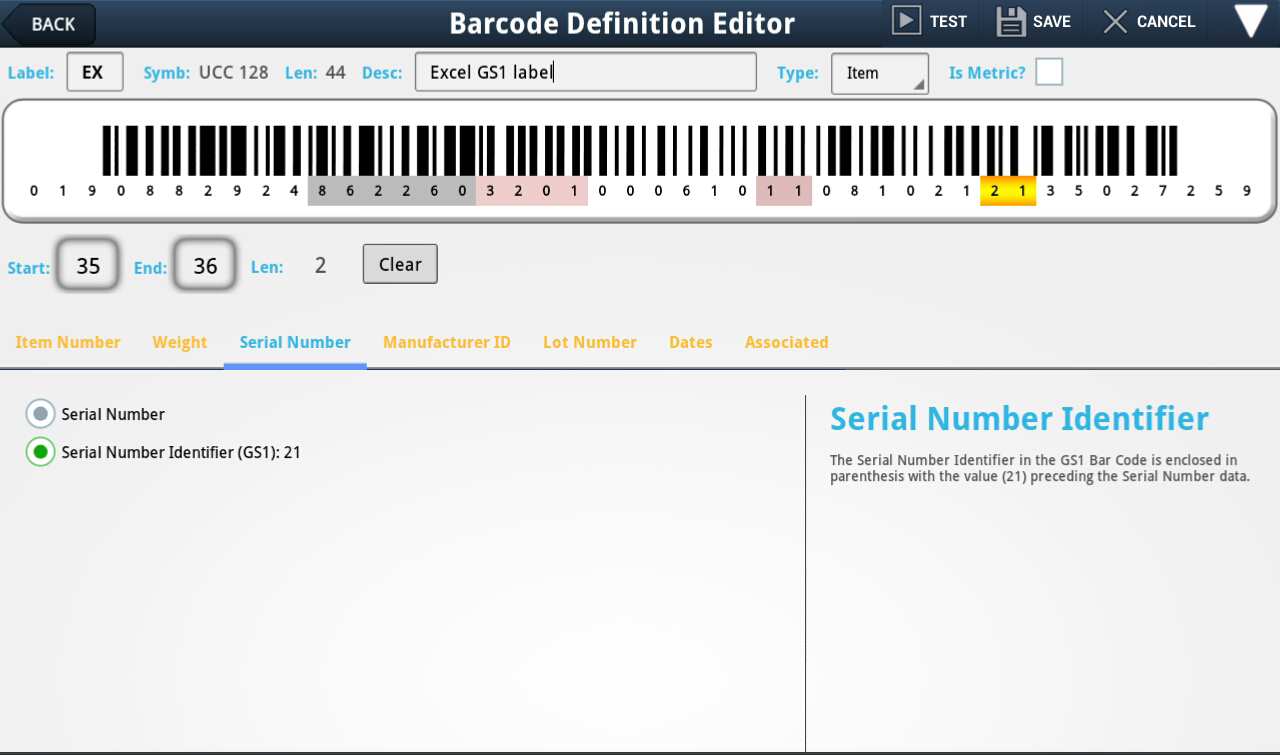
Defining Normal Bar Codes
To help you more quickly identify the elements of a bar code label, the manufacturer can usually provide you with a breakdown sheet. The breakdown information for the bar code includes what fields are contained in the bar code and their start and end values. Here is an example of the break down you would get for a Tyson Pork bar code.
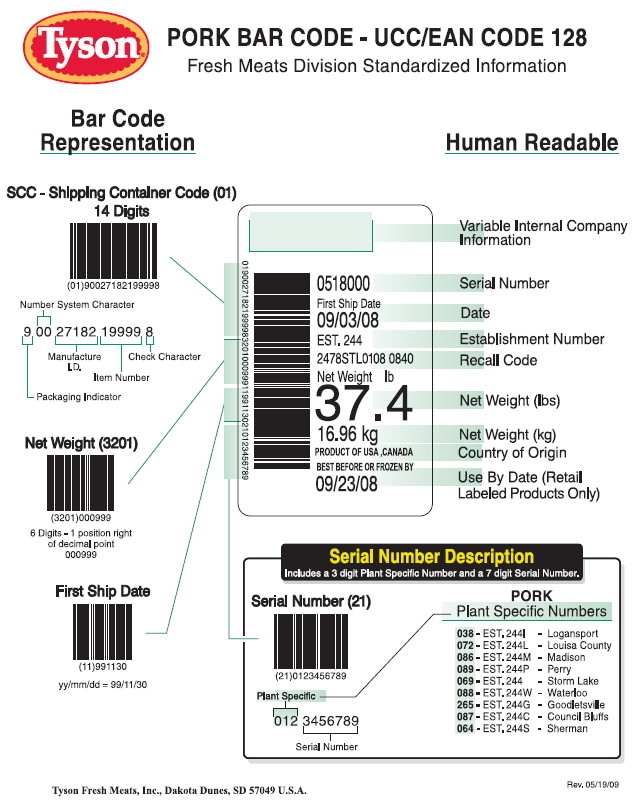
Error Checking
The second thing we are able to do with the GS1 data is to perform some basic error-checking when you are creating a new bar code definition. Some of the GS1 "Application Identifiers" specify not only what a particular value represents but, in some cases, how it should be interpreted. By having the bar code definition editing process interpret an identifier according to the GS1 specification we can perform some simple checks to make sure that the way you have defined the data field is consistent with what the vendor says is the actual content of the field. We'll get into this feature in more detail shortly.
Defined Date Values
The GS1 standard defines four different date values which may be associated with an item:
1. Production Date
2. Packaging Date
3. Sell-By Date
4. Expiration Date
You will only see one of these values, maybe two, in a single bar code. The bar code definition system has been expanded to add support for specifying all four of these date values. Also, since one of these dates may serve, either officially or unofficially, as the item's "Lot Number", the field definitions for these date values include a check box which allows you to designate one of them to be recorded as the "Lot Number" value for the scan.
Automatic Lot Tracking
It is especially important that lot tracking is implemented so our customers are in adherence to the new Food Safety Modernization Act (FSMA). Lot tracking will ensure that your operation is fully prepared in case of a product recall.
EWM includes an effective means for automatically tracking lots, even if you do not use the Lot Tracking features of entrée.
Important The EWM barcode definition must be set up to identify and use the production date encoded in the barcode label as the lot number for automatic lot tracking to work. This information can be the traceable lot number for the item and used when you need to run the Product Recall Report.
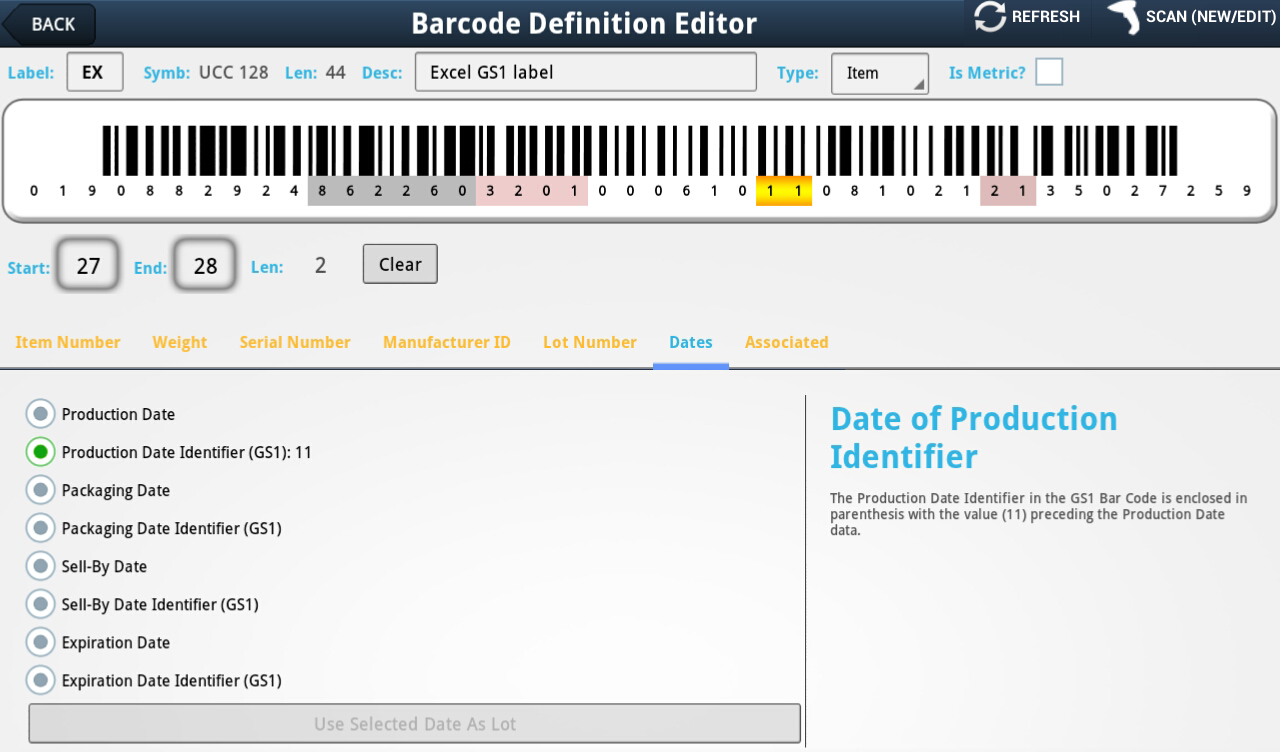
To put it simply, when inventory is received, the scanned lot number (production date) in the label is recorded (along with all other key information). When the product is sold, the lot number (production date) in the scanned label is recorded.
Product Recalls & Lot Numbers in Bar Code Definitions
A product recall can be issued against any of the data values present in a bar code, so it would be beneficial to define the “Lot Number” field in the bar codes that provide one, along with any of the four date fields. Defining and scanning for this bar code data will enhance your businesses ability to trace all activity on a given product using the Product Recall Report in the main entrée system. This enables you to respond quickly in the event of a product recall and stay in compliance with the Food Safety Modernization Act (FSMA).
GS1 Data Values
Although there is a wide variety of data values which can be identified under the GS1 standard, there are really just a few which affect the system. They are as follows:
Data Value |
GS1 Identifier(s) |
Data Length |
Global Trade Item No. (GTIN) |
01 |
fixed length 13 digits (GTIN-13) |
Lot Number |
10, 23 |
up to 20 alphanumeric characters |
Serial Number |
21 |
up to 20 alphanumeric characters |
Production Date |
11 |
exactly 6 digits (YYMMDD see *) |
Packaging Date |
13 |
exactly 6 digits (YYMMDD) |
Sell By Date |
15 |
exactly 6 digits (YYMMDD) |
Expiration Date |
17 |
exactly 6 digits (YYMMDD) |
Net Weight, Kilograms |
310x (see +) |
exactly 6 digits |
Gross Weight, Kilograms |
330x (see +) |
exactly 6 digits |
Net Weight, Pounds |
320x (see +) |
exactly 6 digits |
Gross Weight, Pounds |
340x (see +) |
exactly 6 digits |
* The date identifier values are each two digits long then the following six digits represent the date value. The "YYMMDD" notation indicates that the format of the date is a two-digit year ("YY"), a two-digit month ("MM") and a two-digit day ("DD"). So a bar code containing "(11)081016" in the man-readable portion of the label then the value is a "Production Date" ("11") and so then "081016" represents October 16, 2008. No, the "2000" part is not explicitly specified anywhere but the standard specifies that, much like the way entrée itself handles two-digit years, years from 00-50 should be interpreted as 2000's and years from 51-99 should be interpreted as 1900's.
+ The weight identifier values are each four digits long and then the following six digits represent the weight value. The "x" in the identifier represents the number of decimal places in the weight. So if you see "(3201)000450" in the man-readable portion of the label then you know that the "000450" value represents the weight of the item. The "320" portion means that it is a Net Weight value which is expressed in pounds. The "1" (in "3201") indicates that the weight is expressed to one decimal place which makes the weight value in this bar code 45.0 pounds. If the label read "(3202)000450" then the weight value is still "000450" but now the final "2" (in "3202") means that there are two decimal places in the value making the weight 4.50 pounds.
•For more information about GS1 Bar Code terminology see the GS1 Bar Code Glossary.

GS1 Bar Code Tips
Application Identifiers help you extract the information correctly from a bar code label.
 If you associate the "3201" identifier with the weight value for this bar code but you have defined the "Weight Decimal Length" value as "2" then a warning will be raised since the specified ID value indicates there is only one decimal place. Or if you had a "3101" identifier but had not checked the "kilograms" option, again, a warning would be raised. In either case, it will be up to you to evaluate the situation and make any necessary corrections since the program has no way of knowing if you just typed "3101" by accident when you meant to type "32" or if the item weight really is in kilos.
If you associate the "3201" identifier with the weight value for this bar code but you have defined the "Weight Decimal Length" value as "2" then a warning will be raised since the specified ID value indicates there is only one decimal place. Or if you had a "3101" identifier but had not checked the "kilograms" option, again, a warning would be raised. In either case, it will be up to you to evaluate the situation and make any necessary corrections since the program has no way of knowing if you just typed "3101" by accident when you meant to type "32" or if the item weight really is in kilos.
▪All of the data from the fields you have specified in the bar code definition are recorded in the scan queue files including the four possible date values.
▪All scan data is now recorded with the ID value of the user who performed the scan as well as a time stamp for when the scan was recorded.
GS1 Bar Code Note
Some manufacturers produce bar codes which generally follow the GS1 Standard guidelines but which are encoded with "Code 128" symbology rather than "UCC-128".

